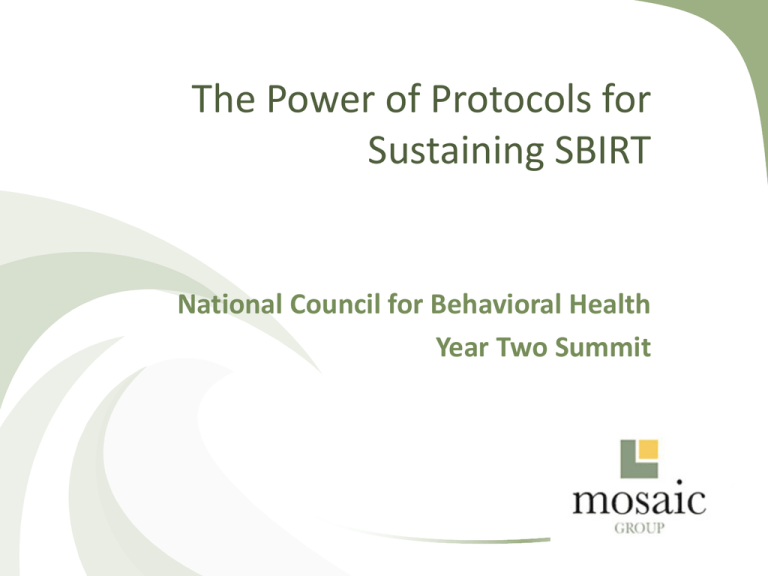The Power of Protocols for Sustaining SBIRT
advertisement

The Power of Protocols for Sustaining SBIRT National Council for Behavioral Health Year Two Summit Expansion and Sustainability Objectives • SBIRT pilot interventions proven successful • Practice culture ready to SBIRT to scale • SBIRT adoption as a routine part of care across all of the appropriate clinical areas • Organizational infrastructure and capacity built to sustain SBIRT practice What We Know About Practice Adoption and Sustainability • • • • • • Culture ready and willing Leadership supportive Workflow drives practice integration Training and re-training essential Data driven monitoring critical early and ongoing Clinical decision support and reminder systems through EHR key facilitator • Guidelines or Protocols documenting procedures for all aspects of practice mandatory What are Practice Guidelines and Operating Protocols? • Practice Guidelines: – Based on scientific evidence about SBIRT intervention – TIP, other research studies – Systematically developed into organizational policy that guides clinical decision making – Allows for measurement of the impact of care through written definition of intervention – Reduces variation in practice through effort to define standardization of interventions What are Practice Guidelines and Operating Protocols? • Operating Policies and Procedures: – Provide standardization for essential operational activities within the clinical practice – Provide clarity on how to execute activities that are important to practice and necessary for regulatory, reimbursement or other accountability factors – Define roles and responsibilities of team members – Help assure execution of key activities when daily practice burden may hinder implementation – Transcends transitions in leadership and staff – written and approved regardless of changes Key SBIRT Guidelines and Protocols • • • • • • Clinical guideline or SBIRT implementation Referral to treatment Documentation through EHR Quality improvement On boarding of new staff Competency-based evaluation Clinical Guideline for SBIRT Implementation • Defines the clinical pathway or protocol for SBIRT practice • Identifies policy for SBIRT: – Target population for screening and intervention – Screening frequency – Purpose of intervention • Defines screening instruments • Defines positive and negative screening result interpretation • Identifies roles and responsibilities of staff for all components of the SBIRT process • Establishes decision pathway for various patient presentations to guide staff interventions Referral to Treatment • Defines process to facilitate hand-off from brief intervention to steps required for successful referral to treatment • Addresses roles and responsibilities of various staff • Defines process for staff tasked with RT responsibility to refer or assist patient in referrals: – Identifies process for each type/category of treatment resource (public, private, crisis, information-line) – Provides guidance on referral options for different patient preferences (MAT for opioid addicted, inpatient for complex patients) – Provides detailed listing and profiles of different treatment resources – Identifies protocol for follow-up by referring provider – Defines documentation • Provides a tool for assessing barriers to access requiring assistance by the practice Referral to Treatment Referral to Treatment The primary goals of referral to treatment (RT)are to identify an appropriate treatment program and to facilitate engagement of the patient in treatment.* • RT can be a complex process involving coordination across different types of services. • It requires a proactive and collaborative effort between SBIRT providers and those providing specialty treatment to ensure that a patient, once referred, has access to and engages in the appropriate level of care. *Tap 33 Systems-Level Implementation of Screening, Brief Intervention, and Referral to Treatment Referral to Treatment: Considerations • • • • Availability of resources for treatment Knowledge by staff on available resources Relationships with treatment providers Personalizing the process: ▫ Facilitate call to the treatment provider with patient ▫ Assure the appointment is made ▫ Assist with barriers to accessing treatment ▫ Avoid just handing patient “a piece of paper” ▫ Document referral source and date of appointment ▫ Follow-up and provide reminders –release of information to follow-up • On-site availability or in system support optimal – develop systems for personalized referral Partnership development • Start with providers in which you already have a relationship • Use areas of common interest and build on those areas • Go slow • Try out new service delivery process for a short period of time and revisit. • Introduce staff at your agency to referral partners. Key Questions • Are you able to track a referral to more formal substance use treatment? • How can the use of technology (EHRs, registries, CCD, NWIN Direct) help facilitate the communication of information between your organization and specialty providers? • Are you notified if a client misses an referral appointment? • What are your referral mechanisms and relationships? • What services are provided through your network? • What is your relationship with those providers? • Are the new partners or long standing ones? • Is your treatment team aware of the services offered by your partners? • Do you have a access to different levels of care through your provider networks? Documentation through EHR • Separate protocol/document helps practice understand the following: – Mechanics for modifications/customization of EHR to accommodate tools for SBIRT – Mechanics for future modifications/customization of EHR – Contact information for outside vendors, as appropriate – Data dictionary of operational terms used for coding and documentation – Copies of screen shots – Process for use of the EHR screens for SBIRT documentation (access to different screens required for SBIRT) Quality Improvement • SBIRT data collection should become incorporated as a routine quality indicator • Practices sustain ongoing SBIRT QI by: – Identifying SBIRT measures for screening and brief intervention as part of the practice’s overall QI plan approved by leadership – Protocol developed and approved defining: • Specific indicators and targets (i.e. all patients at every visit will receive a screen – target 75% of patient encounters) • Frequency of data collection • Report format including data dictionary of all indicators • Process for data abstraction from EHR • Roles and responsibilities of staff for data abstraction, data monitoring, and plan of correction • Reporting of measures to medical, administrative and board governance On Boarding of New Staff • Sustaining SBIRT requires that all new staff receive the appropriate training and support to conduct SBIRT • Protocol must be established and reside within the Human Resources department of the organization to address staff and medical provider on boarding process • Ideally SBIRT training should be identified in protocol for orientation of all new staff and the on boarding of all new providers through a checklist or database system, such as Health Stream that document that SBIRT training occurred as part of new staff/provider orientation • Use of in-person trainings or web-based training should be standardized as the mode of training for new staff • An SBIRT Coach identified within the organization is useful to help provide ongoing coaching and support after initial training • All of the above steps should be detailed in the appropriate new staff and provider on boarding policy and procedure manuals of the organization Competency-Based Evaluation • In order to support quality and fidelity of SBIRT implementation, the practice should define in a written protocol the mechanism for regular competency-based evaluation of all staff involved in SBIRT: – Competencies/skills to be evaluated for each component of SBIRT by the appropriate staff member (i.e. assessment of screening broken down by skills required for Medical Assistant evaluation) – Frequency of competency-based evaluation (no less than annually) – Mechanism for evaluation (standardized patient, role play for observation, observation in practice, written test) – Staff member responsible for conducting evaluation – Minimum level of proficiency required – Policy for staff that do not meet standard level of proficiency – Documentation method- preferably incorporated into broader competency-based evaluation instruments Summary • SBIRT practice adoption as a routine, sustainable part of care is hard work!!!! • Written protocols for key components of SBIRT implementation ensure sustainability and quality: – Prevents selective memory loss of how the team decided to implement various aspects of SBIRT – Withstands changes in key staff positions that hold institutional memory of how SBIRT was implemented – Integrates SBIRT as part of the overall organizational polices, procedures and clinical guidelines that are approved by senior leadership, the organization’s governing board and other regulatory bodies (JCAHO, etc) – Assures standardization of critical components of SBIRT to reduce variation in practice and promote higher quality of care – Allows for changes over time in SBIRT implementation Questions????? Contact Info Marla Oros, RN, MS President Mosaic Group 410-852-4263 moros@groupmosaic.com Colleen Hosler, MS Vice President Mosaic Group 443-956-9618 chosler@groupmosaic.com Today’s Presenter Aaron Williams, MA The National Council for Behavioral Health 202-684-7457 ex.247 aaronw@thenationalcouncil.org








